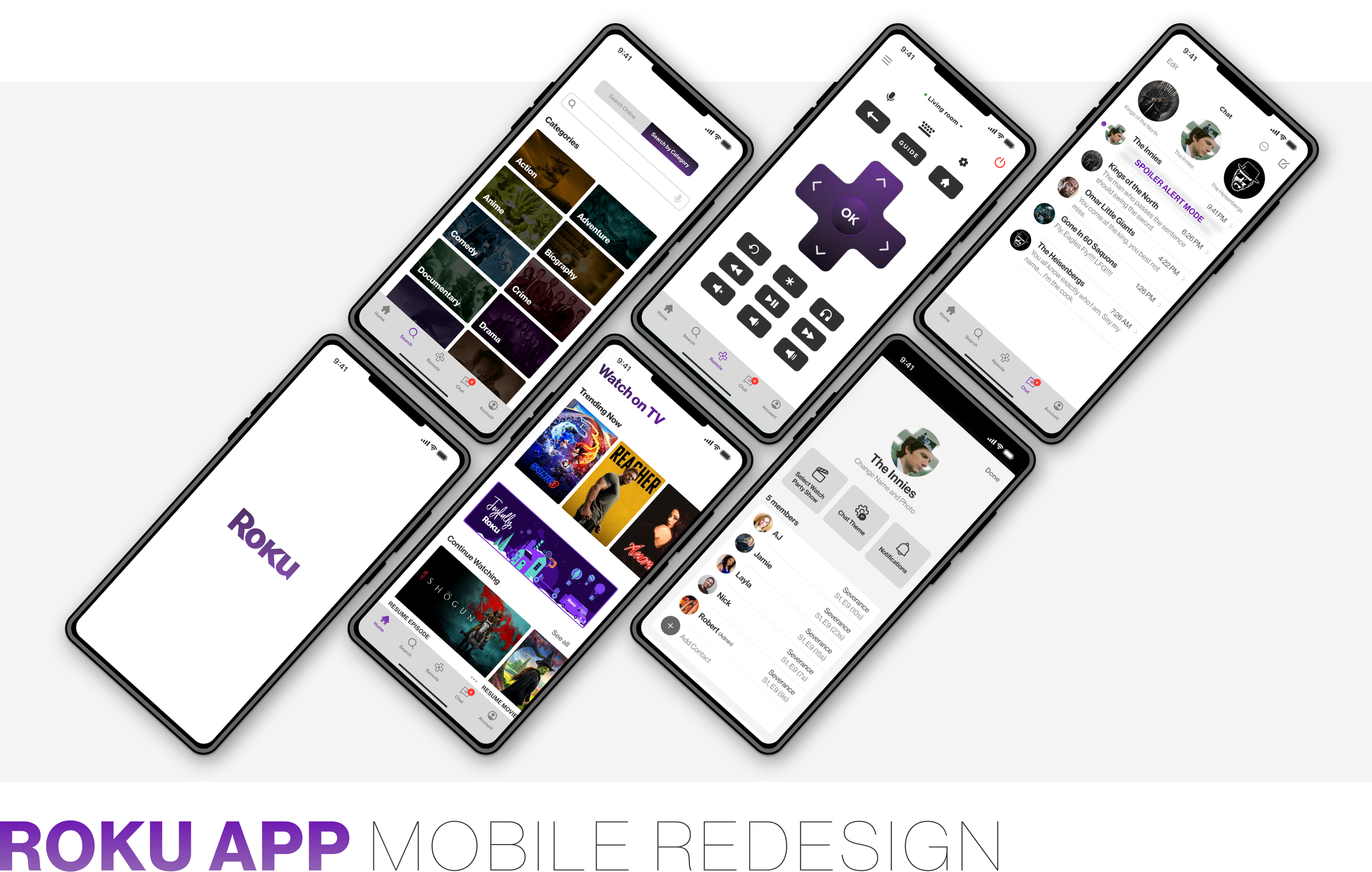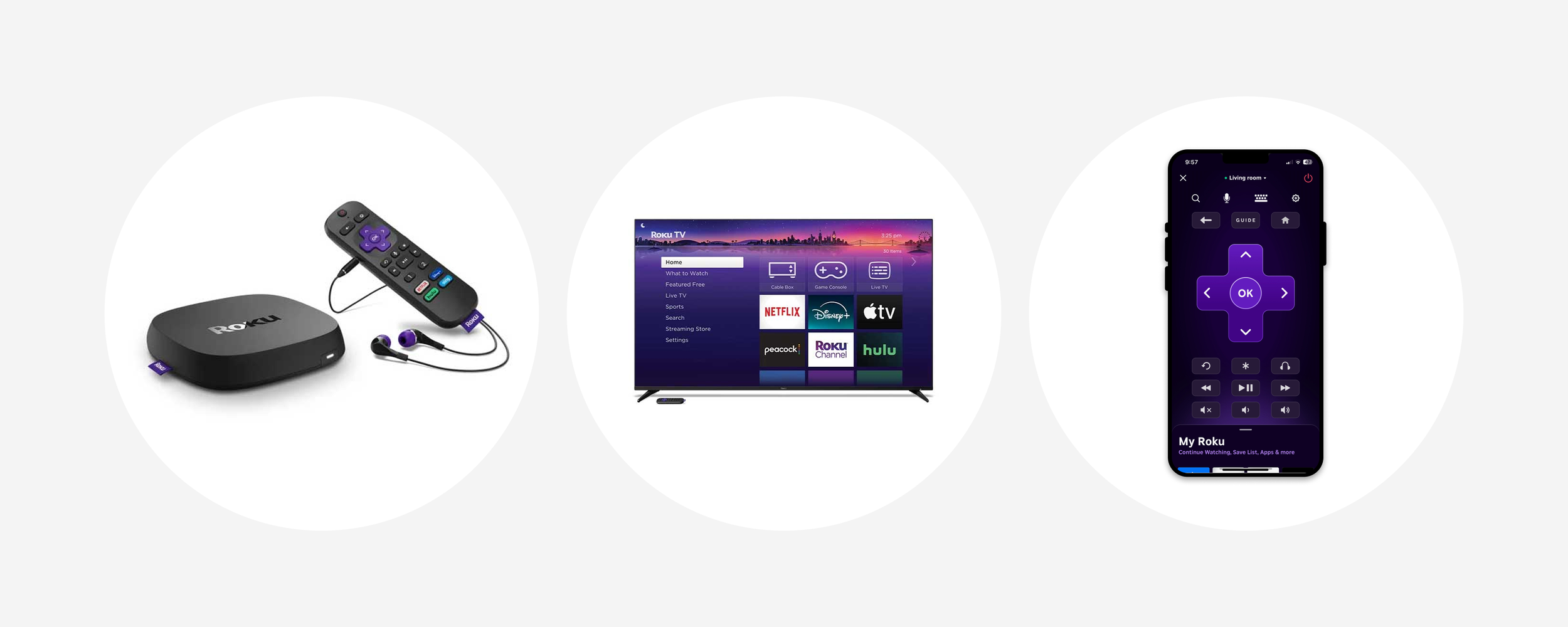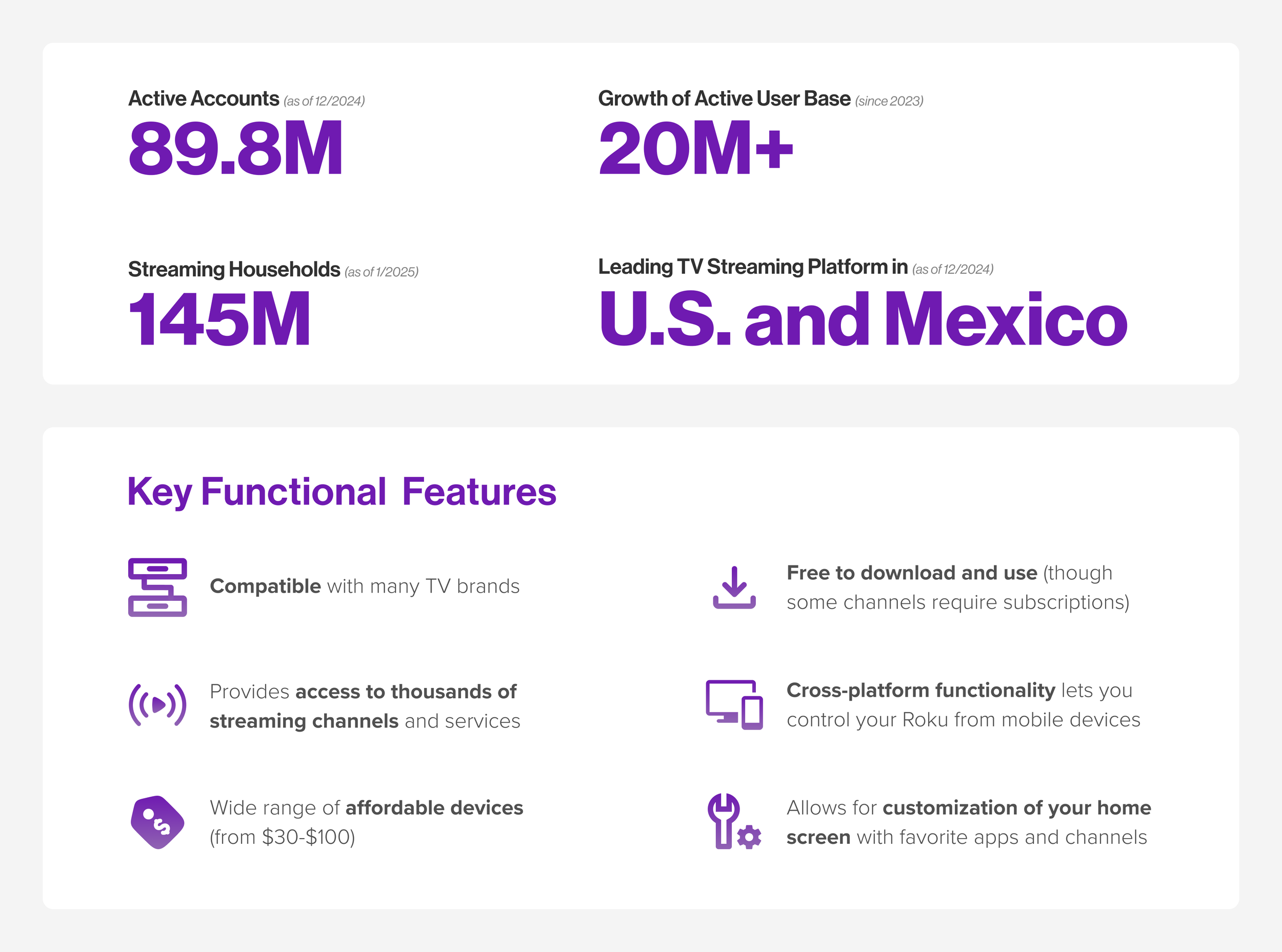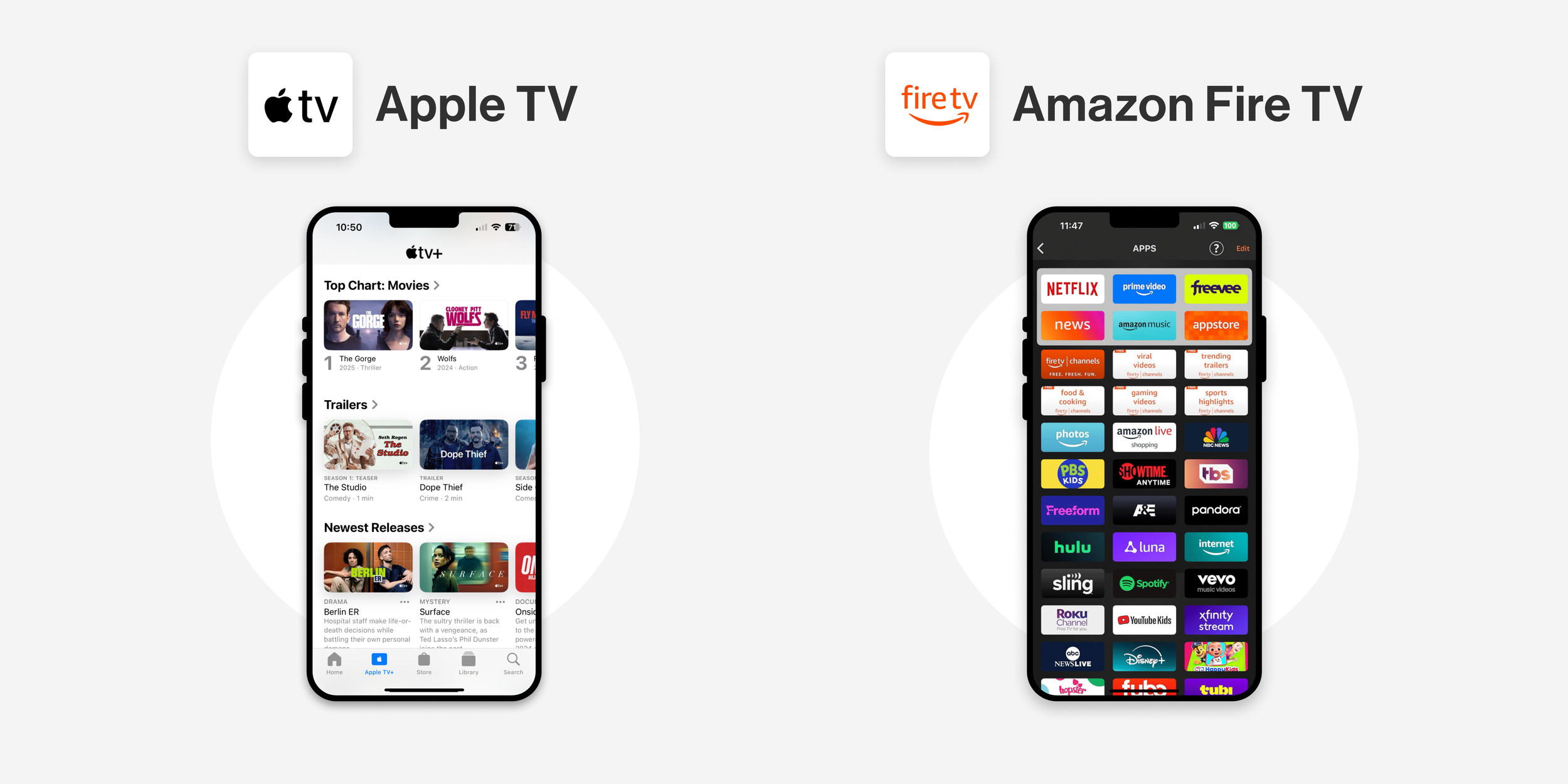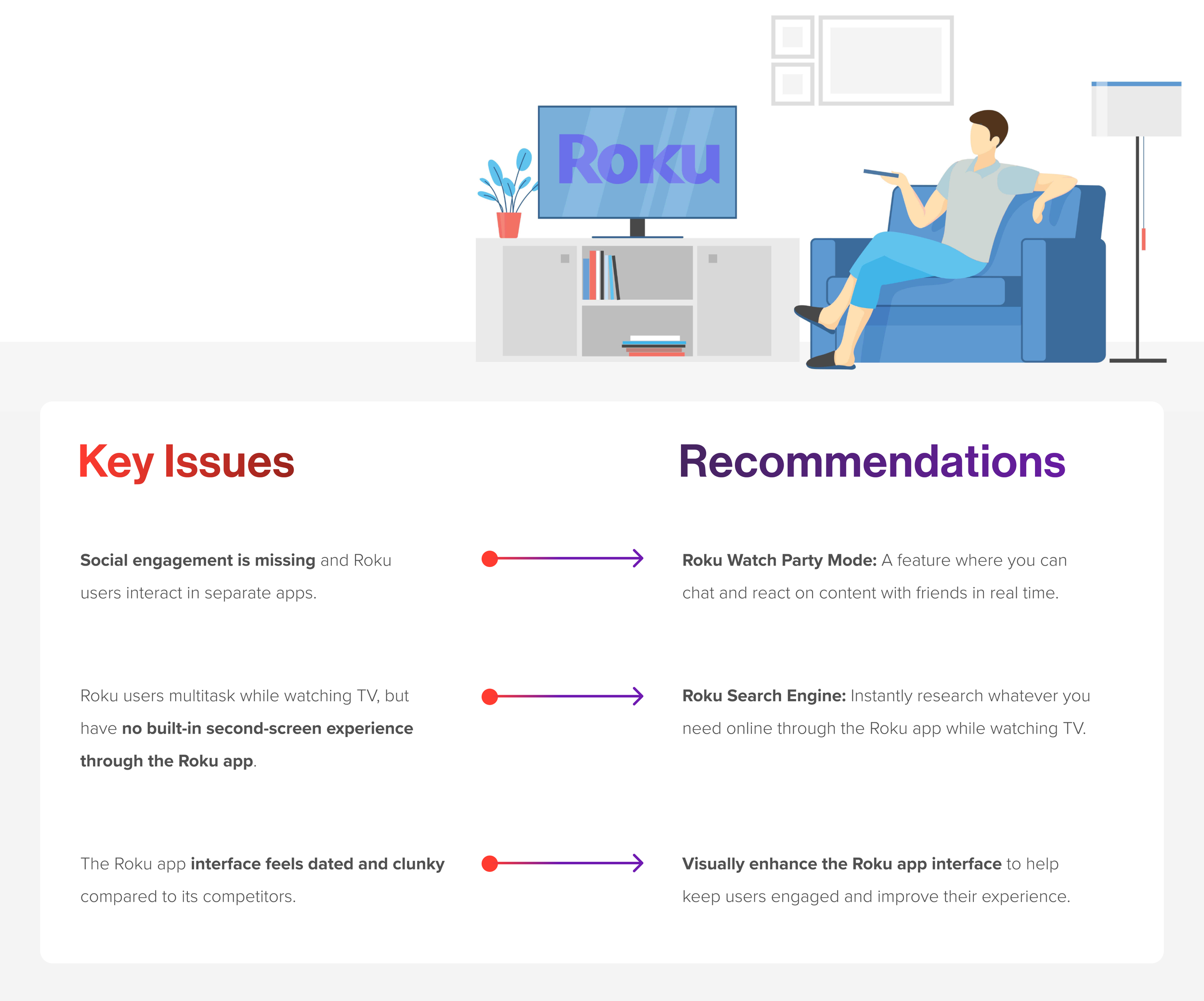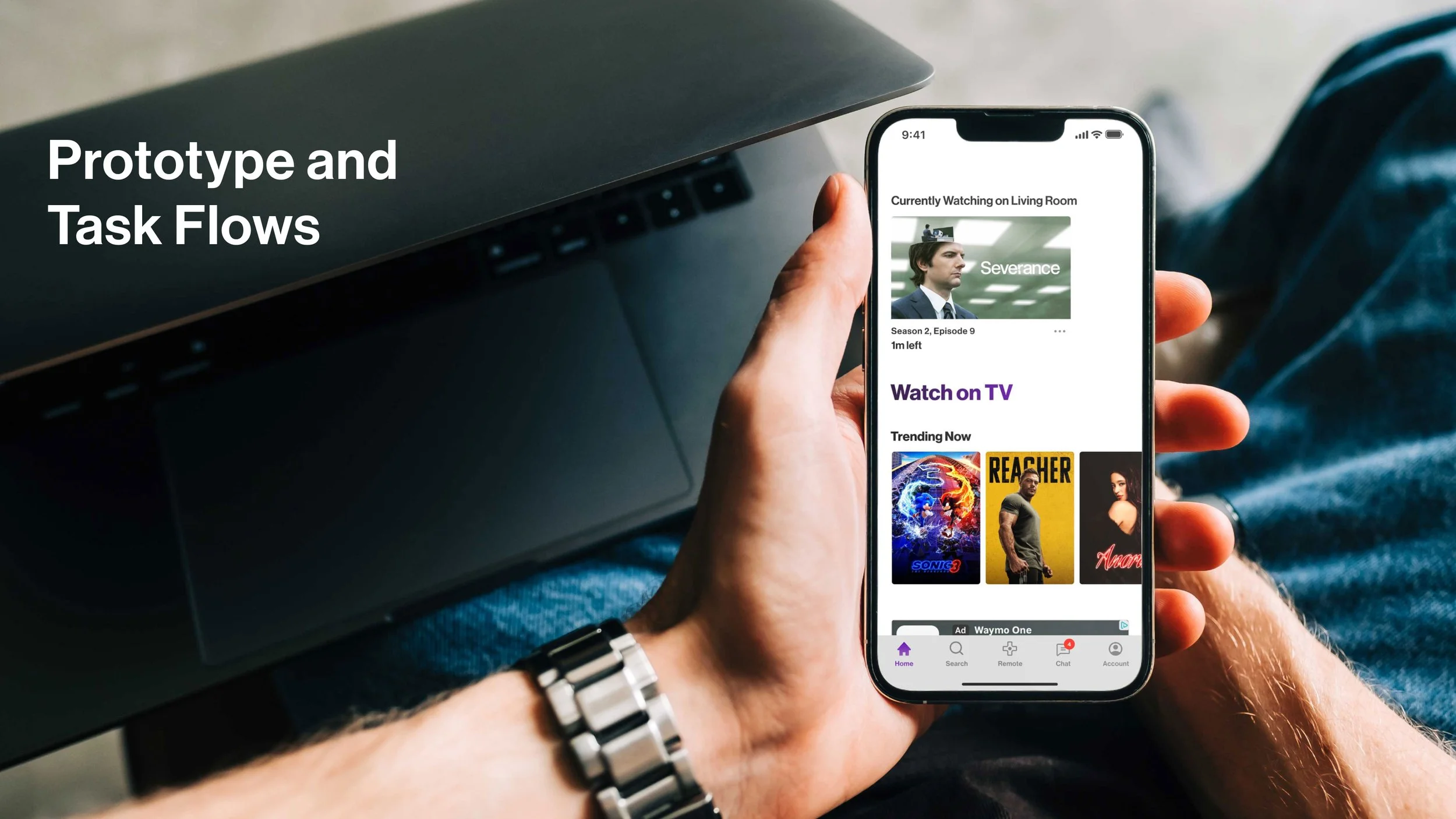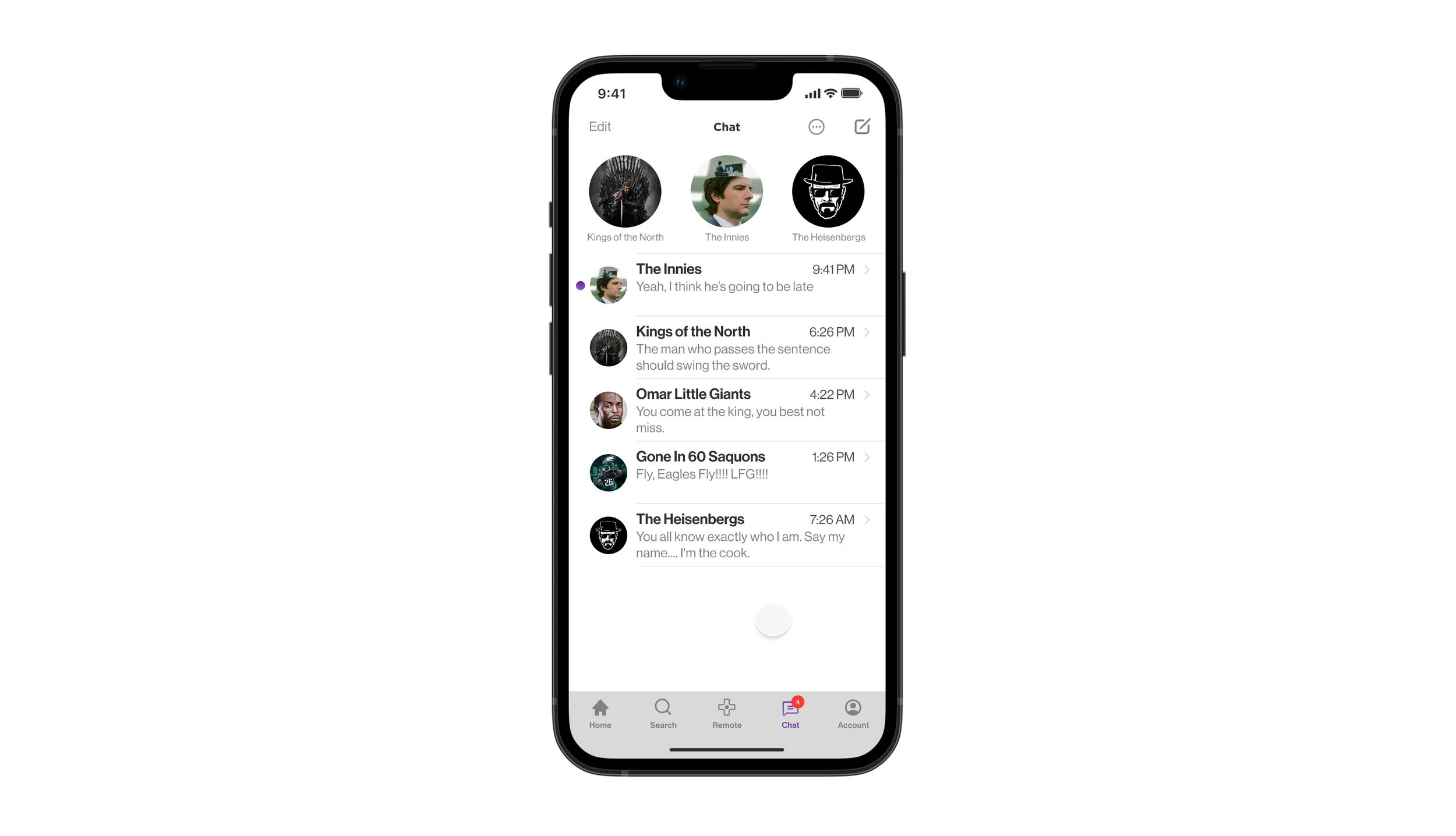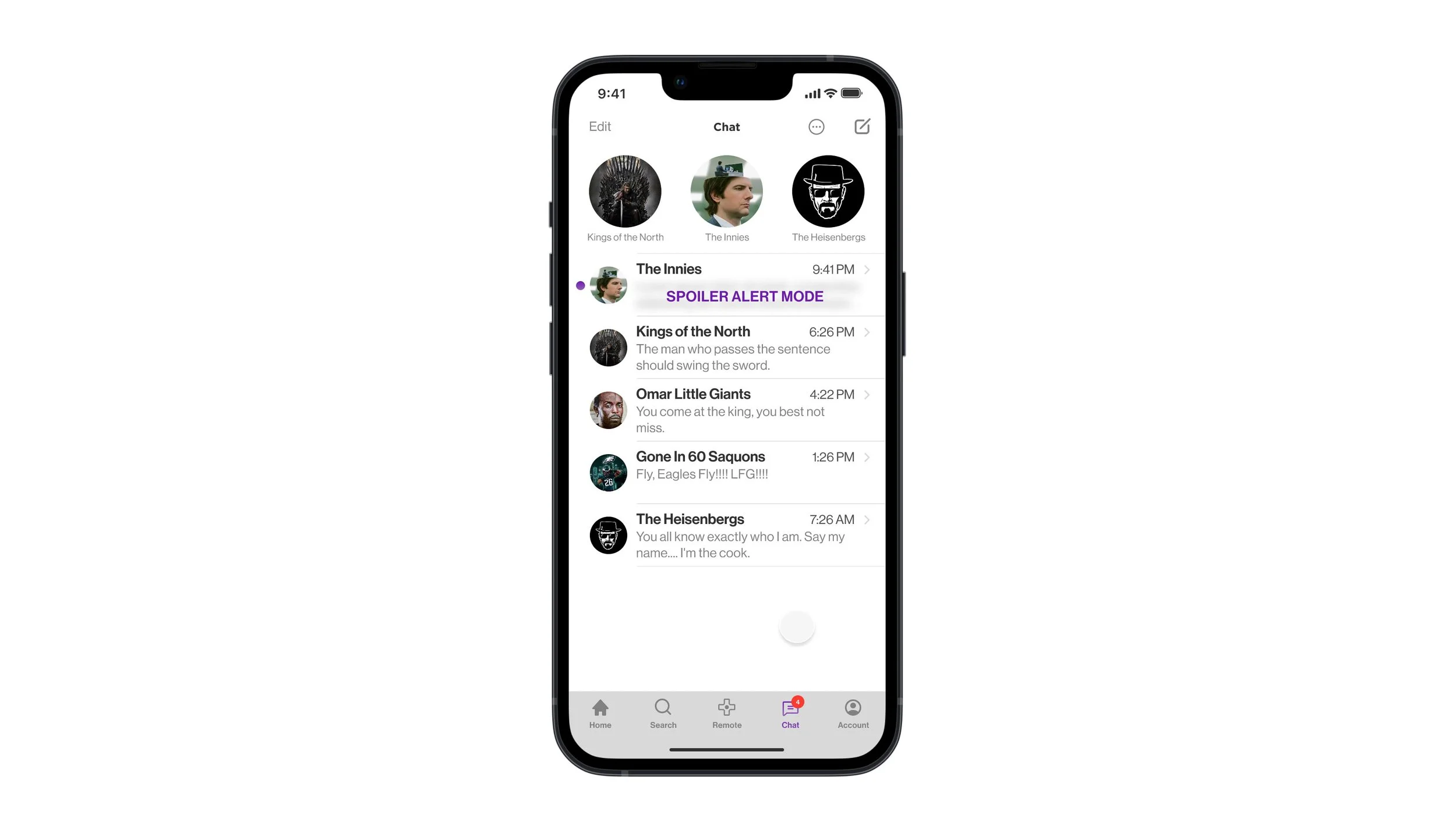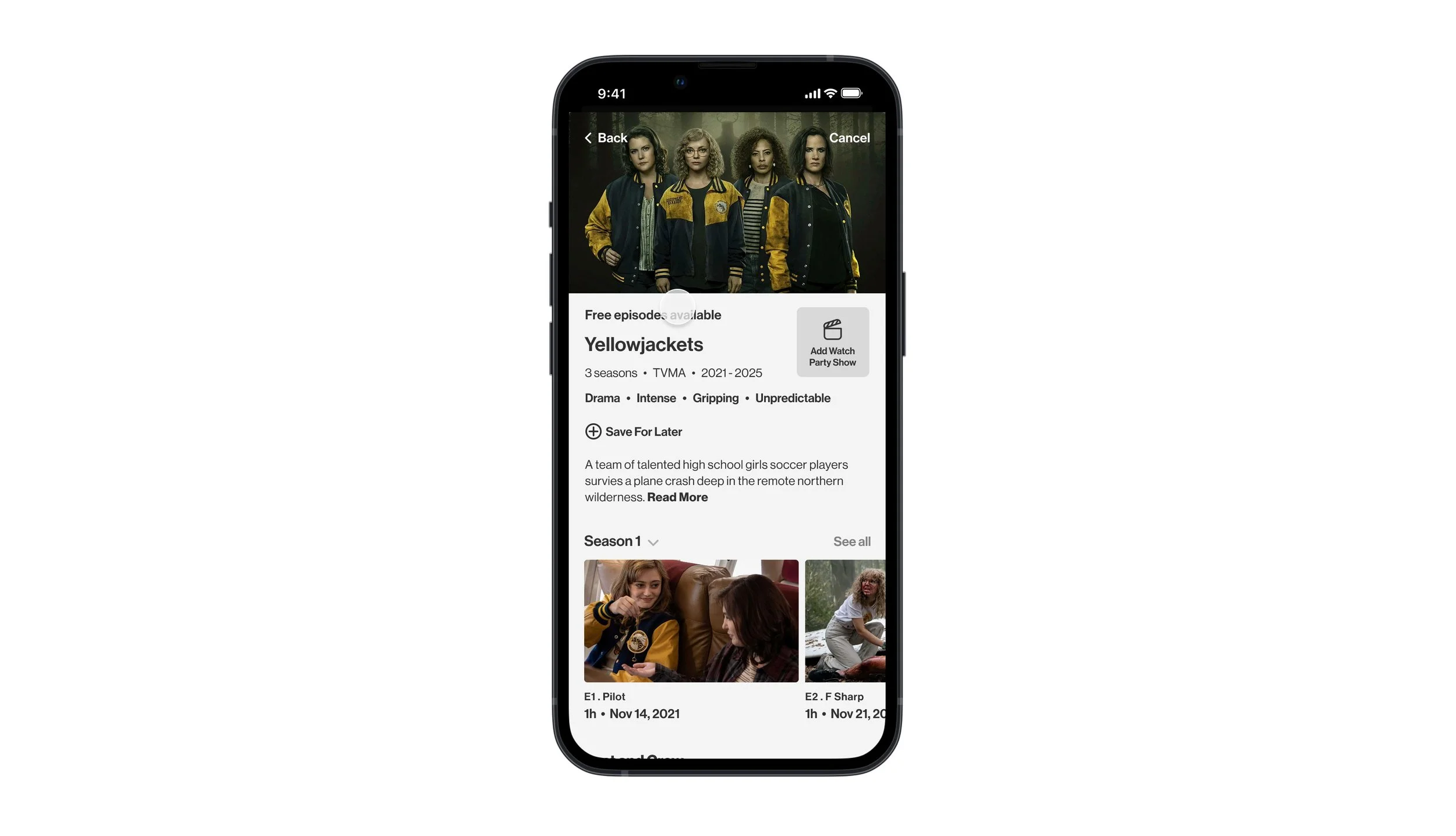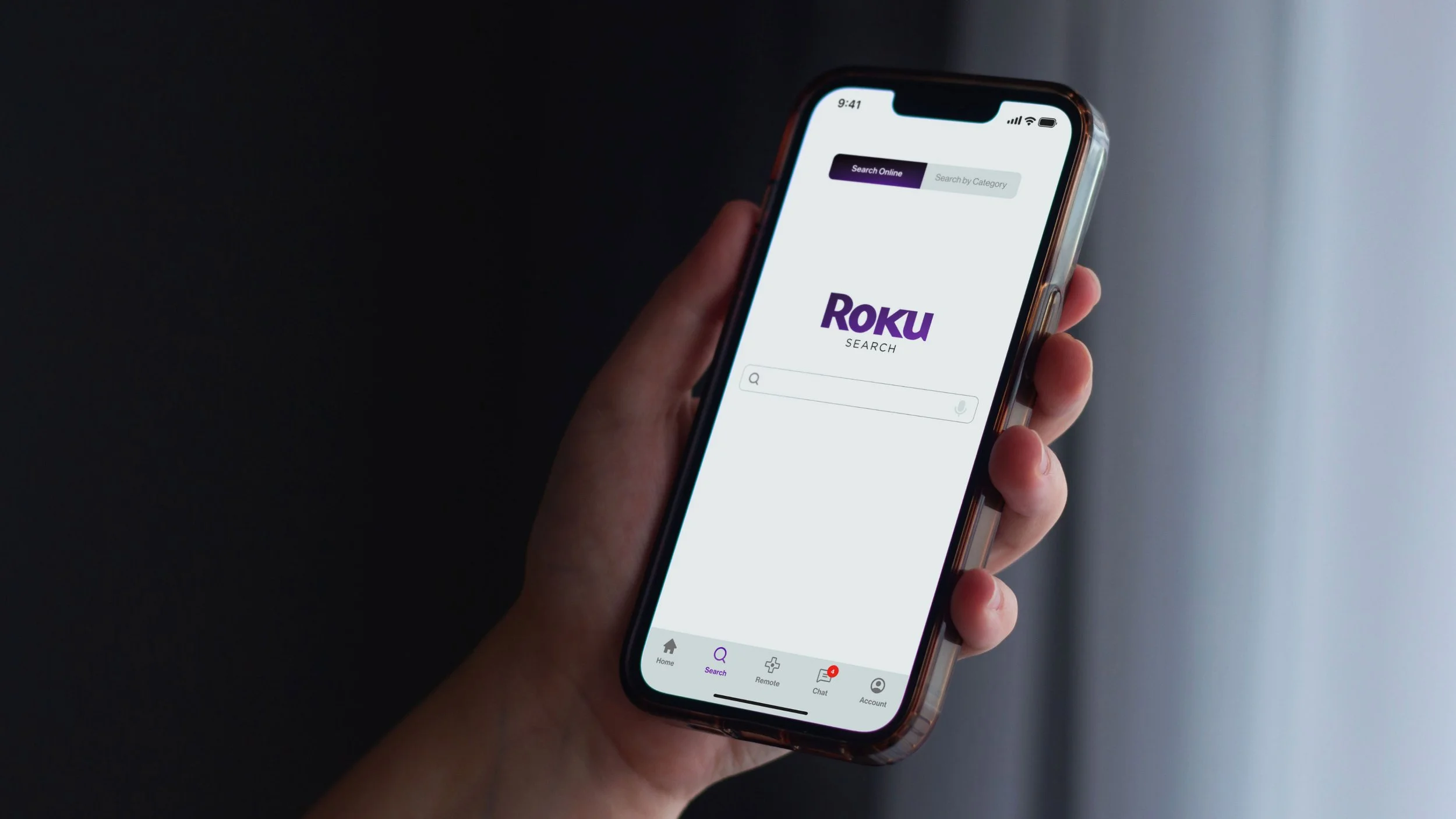ROKU | MOBILE APP REDESIGN CASE STUDY (2025)
My Role — UX Designer / UI Designer / Researcher
Tools — Figma, Photoshop, Zoom, Slack, Toggl, Claude AI
Timeline — 2.5 Weeks (Burst Sprint)
PROJECT BRIEF
Roku is an interesting and important player in the current streaming market - rather than licensing and selling its own media to stream, it sells hardware that allows you to use all your streaming accounts (Netflix, Hulu, Disney+, etc.) on one device, from one remote. It’s been a lifesaver for folks who don’t own a cutting edge smart TV,
or an off-brand TV that doesn’t have native apps themselves.
Oddly, many Roku users don’t even know that Roku has an app and most won’t
use it after installing it. While the TV UI for Roku is mostly seamless, the app seems confused as to its purpose. Is it for finding and playing content? Is it to look up information while you watch? Our objective was to enhance the current mobile Roku app to become THE way of watching accessible TV.
PROCESS AND STRATEGY
After receiving the brief, we collectively came up with a strategy to approach this 2.5 week sprint. It was evident that research would play a key role in identifying pain points that target users experienced when using the product. We then proceeded to sketching and ideation where multiple solutions were explored to address the problematic underlying themes. Those concepts were tested, adjusted and refined multiple times to ensure that our final redesign was an improvement from its predecessor.
WHAT IS ROKU?
Roku is an entertainment platform and device company that offers a variety of options, from live TV to movies that are available on Roku TVs and Roku streaming devices. Roku devices connect to your TV and Wi-Fi network, providing instant access to streaming services like Netflix, Hulu, Disney+, and thousands of others. The Roku App allows users to control their TV with the digital remote feature and perform searches for specific titles, genres, or actors using the app’s voice search feature.
MARKET RESEARCH
As of 2024, Roku is the largest streaming device in the USA. According
to recent market research, Roku leads the streaming device market with approximately 51% market share in the United States. Roku's dominance comes from both its physical streaming devices and its smart TV platform, which is built into many television models.
The closest competitor is Amazon Fire TV which holds around 30-32% of the market share. Other notable streaming devices include Apple TV (around 10% market share) and Google Chromecast (around 7-8% market share).
By the end of 2024, Roku had 89.8 million active accounts worldwide
and reached over 90 million streaming households in the first week of January 2025.
Roku is independent from major streaming subscription platforms, unlike competing streaming devices and connected TVs like those sold by Apple or Amazon. This allows neutrality in promoting content, which some consumers may value.
HEURISTIC EVALUATION
Strengths: The Roku mobile app offers a user-friendly interface that's easy to navigate, with its user interface design following an underlying grid for consistency. Strong branding and use of signature colors create a distinctive visual identity throughout the experience. It provides access to thousands of streaming channels and services, while content is well organized for easy navigation between different categories. The included digital remote enhances control options, complemented by a voice search function for convenient content discovery. A "private listening" feature allows for discreet viewing through headphones connected to your phone, and fast text entry through the keyboard feature makes searching and entering credentials with long character counts much more efficient.
Weaknesses: Navigation menus can feel crowded with possible scenarios of information overload when exploring the app. The visual aesthetics felt dated according to user feedback. No native social or second-screen features exist; users must use separate apps to socially engage. The cluttered ad-supported interface means ads can feel intrusive compared to competitors. Buttons may be difficult to select due to small touch targets on the digital remote, especially for users with larger fingers.
COMPETITIVE ANALYSIS | APPLE TV
Strengths
Offers seamless integration with the broader Apple ecosystem, connecting iPhones, iPads, and Macs through a clean, user-friendly interface that provides an ad-free viewing experience for purchased content.
It supports premium viewing technologies including 4K HDR, Dolby Vision, and Dolby Atmos, while giving users access to Apple TV+ original content and enabling family sharing capabilities across devices.
The platform delivers personalized recommendations and allows users to purchase or rent movies and shows in one convenient location, with offline downloads available for purchased content and no subscription required for basic app functionality.
Weaknesses
Despite these advantages, Apple TV has several notable drawbacks, including the requirement of an Apple TV+ subscription to access original content and higher rental and purchase prices compared to competitors.
The platform offers limited free content options and isn't available on all non-Apple platforms, while its content library remains smaller than major competitors like Netflix.
Users must manage separate subscription costs for additional channels, and the search functionality sometimes lacks precision.
The inconsistent integration with some third-party streaming services can be frustrating, the TV app organization may confuse new users, and certain features require the latest hardware or software versions to function properly.
COMPETITIVE ANALYSIS | AMAZON FIRE TV
Strengths
Offers a compelling streaming experience with its seamless integration into the Amazon ecosystem, providing users with immediate access to Prime Video, Prime Music, and other Amazon services.
Its user-friendly interface enables easy navigation, complemented by convenient voice control capabilities through Alexa that eliminate tedious manual searching. The platform boasts an extensive content library with thousands of apps and channels, while regular updates ensure improved features and performance over time.
Personalization is a key strength, with the system offering tailored recommendations based on viewing habits and convenient cross-device syncing that allows users to continue watching content from where they left off on other devices.
Budget-conscious consumers appreciate the free content options through services like IMDb TV, while the ability to mirror or cast from compatible devices adds flexibility.
Additional conveniences include fast text entry via keyboard and smart home integration capabilities, with the mobile app providing an alternative to the physical remote.
Weaknesses
Despite these advantages, Amazon Fire TV does have notable weaknesses. The platform tends to prioritize Amazon content over other streaming services, potentially limiting discovery of non-Amazon options.
Users may find the ads and sponsored content on the home screen intrusive, detracting from the viewing experience. Performance issues and buffering can occasionally disrupt streaming, while some apps lack optimization specifically for Fire TV.
Gamers may be disappointed by limited gaming capabilities compared to dedicated systems.
A stable internet connection is essential for optimal performance, and additional subscriptions are required for certain premium content.
The search functionality sometimes struggles to find content across different apps, and the user interface can become cluttered when too many apps are installed, making navigation more challenging.
USER INTERVIEWS
We conducted user interviews with 13 participants, both Roku and non-Roku users, to explore their television habits, interactions with modern technology, and phone usage while watching content. By analyzing how target users interact with the current app, we identified its strengths and weaknesses, enabling us to make improvements that align with user needs.
AFFINITY MAPPING
After all video sessions were recorded and transcribed, multiple insights were pulled from each interview. Their responses were then placed into an affinity map to determine key underlying themes and categories that were important to the target users. The following four “I statements” were identified as key user habits.
PROBLEM STATEMENT
Robert needs a better way to look up information on content he’s currently watching on TV because he doesn’t want to go through multiple sites to find an answer. He needs a more efficient system that enhances his viewing experience and enables easier communication with friends about shared content.
IDEATION
I refined the Roku app while preserving its essential identity as the market-leading streaming platform. My process began with careful tracing of the existing screens to create low-fidelity wireframes, making only minor spacing and padding adjustments while maintaining the core structure.
The high-fidelity wireframes showcase a significant visual transformation. I shifted from the dark purple background to a clean, minimalist white interface where purple now serves exclusively as an accent color for interactive elements like icons, buttons, and watchlist content. Additionally, I introduced a new group chat feature in the navigation bar, replacing the previous "devices" section.
TASK FLOW 1: Roku watch party (1/2)
Robert is working late and realizes he won't make it home in time for the Severance season finale with his friends. He sends them a message to let them know, then activates "Spoiler Alert" mode in the Roku Watch Party group chat to avoid seeing any spoilers. He also checks the group chat settings to see where his friends are in their viewing progress of the show.
Roku's "Spoiler Alert" feature protects viewers from plot reveals during group viewing sessions. Users can control incoming messages, allowing them to finish shows without disruption from unexpected spoilers. The group chat settings page also displays timestamps showing each participant's progress in the shared program, making it easy to track where friends are in the viewing experience.
TASK FLOW 2: Roku watch party (2/2)
After watching the Severance season finale, Robert returns to the Roku Watch Party group chat, turns off “Roku Watch Party” group chat and to catches up with his friends about the episode.
When "Spoiler Alert" mode is active, all group member messages are automatically blurred. Notifications are silenced while this mode is on. You can reveal messages by tapping them individually or by turning off "Spoiler Alert" mode, which will show all previously hidden messages in the thread.
TASK FLOW 3: SELECTING A NEW Roku watch party SHOW
Now that the season is over for Severance, the Robert needs to select a new show for his Roku Watch Party group.
Roku users can now enjoy "Watch Party Shows" with their friend groups, making the viewing experience more social and interactive. Group administrators can access detailed information about available content before making selections for the group. During the search process, they'll find comprehensive details including plot summaries, cast information, and other key show information to help make informed choices.
TASK FLOW 4: Researching with the Roku App
Robert’s kids are watching Sonic the Hedgehog 3 in the next room. He recognizes one character's voice—Shadow the Hedgehog—but can't quite place who the actor is. Determined to solve this mystery, he opens the Roku app on his phone to identify the voice actor.
Our research revealed that the majority of users conduct web searches on their phones while watching TV. "Roku search" enables users to search the web without leaving the Roku app, reducing the number of clicks needed to find information and expediting the process.
Figma file can be found here.
